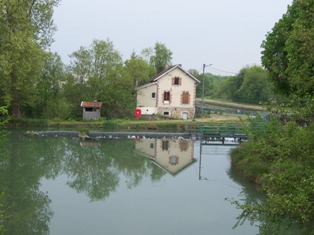La
région occupée par le village de Saint Martin était habitée depuis
longtemps. La mise au jour, en 1875, à proximité du centre du
village, d'une station préhistorique de l'age de la pierre taillée,
a révélé qu' un groupe d'individus vuvait déjà à cet endroit plus
de cinq mille ans avant notre ére.
Divers objets trouvés au même endroit ou en d'autres points du
territoire, permettent d'affirmer que les environs du village ont
été habités aux époques gauloise et gallo-romaine.
Trois siècles plus tard, le christianisme fait son apparition en
Gaule. Le grand Saint Martin, évêque de Tours, est de passage en
Champagne et donne son nom à de nombreuses localités
traversées.
Au Moyen-Age, l'histoire de notre village se confond avec
l'établissement et le développement des biens écclésiastiques qui
s'y forment dés le XIIème siécle, ceux de l'Abbaye de
Saint-Pierre-aux-Monts et du Prieuré de Vinetz. La communauté de
Saint Martin fait partie du domaine de l'évêque comte de Châlons,
qui renoncera à ses droits en 1329, au profit des religieux de
Vinetz qui deviendront seigneurs de Saint Martin les Vinetz.
A la fin du XVIème siècle, apparaît le nom de Saint Martin sur le
Prez.
Au XVIIIème siècle, on retrouve les formes primitives de
Saint-Martin-les-Vinets ou encore de Saint-Martin-et-Vinets.
Vers 1812, la commune est définitivement appelée Saint Martin sur
le Pré. Pourquoi "sur le pré"? Parce que le village est situé à
proximité d'une vaste prairie qui s'étendait jusqu'au lit de la
Marne. Cette prairie servait de paturage commun. Elle était
innondée chaque hiver, donc fertilisée par le limon du cours d'eau.
Elle produisait une herbe de choix, qui pouvait nourrir une partie
de l'année toutes les bêtes de la localité.
Region occupied by the village of Saint
Martin was inhabited long. The discovery in 1875 near the center of
the village, a prehistoric site in the Age of carved stone, has
revealed that a group of individuals vuvait already located more
than five thousand years before our era.
Other items found
at the same place or elsewhere in the country, can say that the
village was inhabited in periods Gallic and Gallo-Roman.
Three centuries
later, Christianity appeared in Gaul.
The Great St.
Martin, bishop of Tours, is visiting the Champagne region and gives
its name to many places visited.
During the Middle
Ages, the history of our village is identified with the
establishment and development of ecclesiastical property which
compose the dice XII century, those of the Abbey of
Saint-Pierre-aux-Monts and the Priory Vinetz.
The community of Saint
Martin is the domain of the Earl Bishop of Chalons, who will
relinquish his duties in 1329 in favor of religious Vinetz who
become lords of the St. Martin Vinetz.
At the end of the
sixteenth century, appears the name of St. Martin in the
Prez. In the eighteenth
century, we find the primitive forms of Saint-Martin-les-Vinets or
Saint-Martin-and-Vinets.
About 1812, the
town is definitely called St. Martin's Pre. Why "the meadow"? Because the village is located near a
large meadow that stretched to the bed of the Marne.
This meadow was used as common
grazing. She was
flooded every winter, thus fertilized by the silt of the
stream. It produced an
herb of choice, which could feed a part of the year all the beasts
of the locality.
